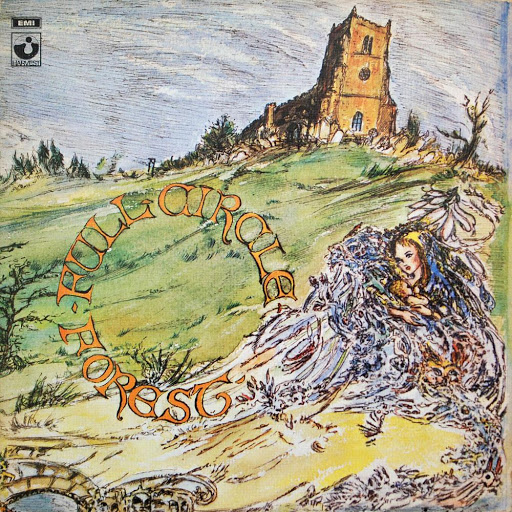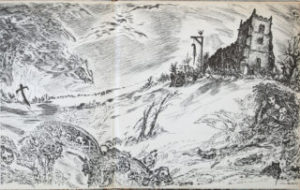
Forest – Full Circle (1970)
After my first magic mushroom psilocybin psychedelic experience at the age of nineteen, I decided that my screen name should be Graveyard Poet. There were three inspirations for this name at the end of my teenage years: 1.) the poem “Elegy Written in a Country Churchyard” by Thomas Gray (whose birthday was the day before mine, December 26); 2.) the artwork on the back cover of the Verve’s A Storm in Heaven (featuring an old man giving a peace sign in a surreal cemetery); 3.) the song “Graveyard” by the band Forest. During the month of April 2004, a compilation Gather in the Mushrooms: The British Acid Folk Underground 1968-1974 was released. It was through this compilation that I discovered an array of artists (Pentangle, Fresh Maggots, Trader Horne, Vashti Bunyan). There were two artists I discovered whose tracks on the compilation fascinated me: “The Herald” by the band Comus and “Graveyard” by the band Forest.
“Graveyard” contained an acoustic guitar, cello, and whistles that made it sound like it was played by medieval minstrels. The enchanting instrumentation, macabre and mysterious lyrics, and strange singing spoke to me- “In a graveyard I have been, a body I have seen, from the sharp moon I had dreamed, that body was me, twisted faces seem to appear, life full of fear, all at once I stepped out of a dream, but a body, that was me?” The song compelled me to recollect my many visits as a kid to local cemeteries where I would become lost in the peaceful, yet also sinister, stillness of that world. My mushroom trip and the song “Graveyard” made me reconnect with forgotten memories.
A decade passed before I revisited Forest at the age of twenty-nine in October 2014. Throughout my twenties, I had been studying astrology and had reached rock bottom, the lowest time in my life during my first Saturn return (the crisis that forges you into a new person between the ages of twenty-seven and twenty-nine.) Astrology had an explanation for why so many musicians died at the age of twenty-seven. Rather than face Saturn (their ancestral curse or ancestral gift, their roots), the artists are destroyed by their shadows, their skeletons in the closet. At the age of twenty-nine in 2014, I had survived my own self-destructive tendencies. I had been reading about Saturn’s connection to cemeteries in Agrippa’s Occult Philosophy and in Saturn and Melancholy (Raymond Klibansky, Erwin Panofsky, Fritz Saxl).
When I revisited “Graveyard”, I decided to finally listen to the entire album on which the song was featured: Full Circle. Just as the song “Graveyard” had spoken to me at the age of nineteen in April 2004, the album’s title and its closing track “Autumn Childhood” spoke to me at the age of twenty-nine in October 2014. In the liner notes of the record, the opening track on side two “Do Not Walk in the Rain” has these lines typed below it: “One last chance to move round the circle and begin again. But the dangers only remain if you want them to.” In astrology, the return of Saturn marks the turning of the wheel, a turning that recurs throughout life. I did feel as I left my twenties behind and entered my thirties that I had completed the first full circle of my life.
The lyrics of the closing track “Autumn Childhood” (“the dust and cobwebs left a pain that ploughed the furrows of the dead and burning woodsmoke filled my head… autumn spread her wings to fold me”) spoke to my obsession with my ancestors that started at the age of twenty-six when I first changed my last name to my ancestral surname (Lager) and continued into darker realms at the age of twenty-eight when I visited the tomb of the first wife (Anna Maria Dust) of my great-great-grandfather Theodore (the first of my German ancestors in America). Anna Maria Dust tragically died at the end of her twenties/beginning of her thirties in December 1881. I visited her tomb in November 2013. I felt trapped there by her ghost.
What about the band Forest? They were a trio (two brothers, Martin Welham and his younger brother Adrian Welham, and their friend Dez Allenby) from Grimsby, England who moved to Walesby, England in 1967. The band rehearsed and wrote songs in what was, at the time, an empty church- All Saints church (nicknamed the “ramblers” church)- this church is illustrated by Joan Melville on the cover of their album Full Circle and referenced by Dez Allenby in his song “Gypsy Girl & Rambleaway”. In 1970, at the young ages of only twenty and twenty-one, the band recorded Full Circle with producer Malcolm Jones at Abbey Road Studios.
Although the band began with harmony vocals and traditional folk (“Famine Song” is medieval vocalizing, a “tribute to those who starved and are starving”), they had soon each created their own artistic identity through their separate songwriting. Dez Allenby was more contemporary with his songs (the opening track on side one, “Hawk the Hawker” is about the band’s drug dealer, mentioned in the liner notes as “a friend who lays pieces of sunshine on the heads of the unsuspecting and unaware” and has more of an American country rather than British folk feel with guest Gordon Huntley on steel guitar and “Gypsy Girl & Rambleaway” appears to be about hippie women), whereas the Welham brothers explored Britain’s medieval past. Adrian Welham’s songs “Bluebell Dance” and “Graveyard” are adventurous instrumentally with madcap mandolin in the former and whimsical whistles in the latter, while Martin Welham wrote the darkest lyrics on the record.
 Martin Welham’s “The Midnight Hanging of a Runaway Serf” (“a tawny owl with a haunting stare… the prisoner there so alone, so cold… and then the clouds came down and covered the moon, the child proceeding in a twilight state of gloom, they marched him to his fate”) is visually portrayed by Joan Melville’s artwork within the gatefold sleeve.
Martin Welham’s “The Midnight Hanging of a Runaway Serf” (“a tawny owl with a haunting stare… the prisoner there so alone, so cold… and then the clouds came down and covered the moon, the child proceeding in a twilight state of gloom, they marched him to his fate”) is visually portrayed by Joan Melville’s artwork within the gatefold sleeve.
Martin Welham’s “Autumn Childhood”, the closing track, is the most complex song on the album, as its atmosphere and moods shift back and forth between a campfire celebration and the singer’s own death and burial (“Died…died! Yes, I died! They buried me. I went down and down ‘til I cried.”) The group disbanded in 1971.
Forest’s Full Circle is a hidden gem that is still spellbinding fifty years later.
by Mark Lager

Great article/review, Mark. I’ve heard of Forest before. Although I haven’t really jumped into the acid folk scene as much as I probably should. I’m more familiar with Comus’s first utterance. That’s quite a listen. So I’m interested to listen to more. Love the way you weaved your own experiences into the record . Music is such a personal experience and in someways the soundtrack to certain parts of our lives. Sounds like this go perfect with the fall weather.
Shawn,
Comus’ First Utterance is another of my favorite acid folk albums. I always play Comus’ First Utterance on Halloween and on Walpurgis Night.
Forest’s Full Circle does go perfectly with the fall weather (especially “Graveyard” and “Autumn Childhood”).
Found this record in a thrift store!
Cool find!
Hey Mark,
I’ve been listening to the first tracks of this album, it reminds me a lot of Fleet Foxes (one of my favorite bands).
It’s great how you relate astrology with the personal background of these songs. I got a sense of nostalgia, and immediately imagined a group of medieval minstrels playing at the background.
Great work!!
Octavio,
British acid folk/psychedelic folk of the early 1970s is fascinating. Forest instrumentally are medieval sounding and lyrically gothic and nostalgic.
You feature so many gems I’ve never heard of in your unusual pieces, Gustav Holst, Schubert, now this. It’s a real treat. This is by now the only page that I regularly look up for music writing. Everything else is so boring.
Can’t wait for what’s next, great job Marc
Thank You Theo!
Had a listen at this after reading your review. I’ll be honest, at first I thought “Hope it’s not some fluted hobbstweedle shit” because I dislike fluted hobbstweedle tunes. But I was positively surprised! The opener sounds like rare good country-folk to me, and “Do Not Walk In The Rain” is simply great, and the album is at times a great dark/gothic folk record (with a bit of hobbstweedle). It is also featured in one interesting book that I have, called “A Year In The Country: Wandering Through Spectral Fields: Journeys in Otherly Pastoralism, the Further Reaches of Folk and the Parallel Worlds of Hauntology” by Stephen Prince. You might be interested in his series of books.
Loved how you weave in personal bits and astrology to your story- I had never heard about the return of Saturn, it makes sense regarding Club 27 and the crises many people have around that age. I’ll have to explore a bit more about the topic… anyway, I always deeply appreciate it when offered interesting information from fields I’m not well-acquainted or familiar to, like astrology. Thank you for this
Saliha,
Haha–your “hobstweedle” had me laughing. I suppose it has a bit of “hobstweedle” in its instrumental side, but, as you noted, there’s also a darker gothic vibe, especially in the lyrics of “Graveyard”, “Autumn Childhood”, and “Midnight Hanging of a Runaway Serf”.
I have read Stephen Prince, as well as books such as Electric Eden. I am fascinated by the British early 1970s acid folk/psychedelic folk scene. I also dig hauntology (the albums released on the Ghost Box Records label.)